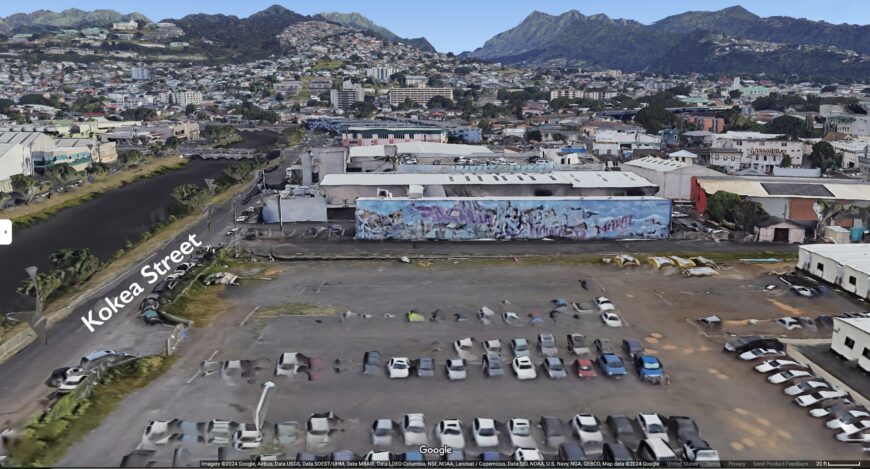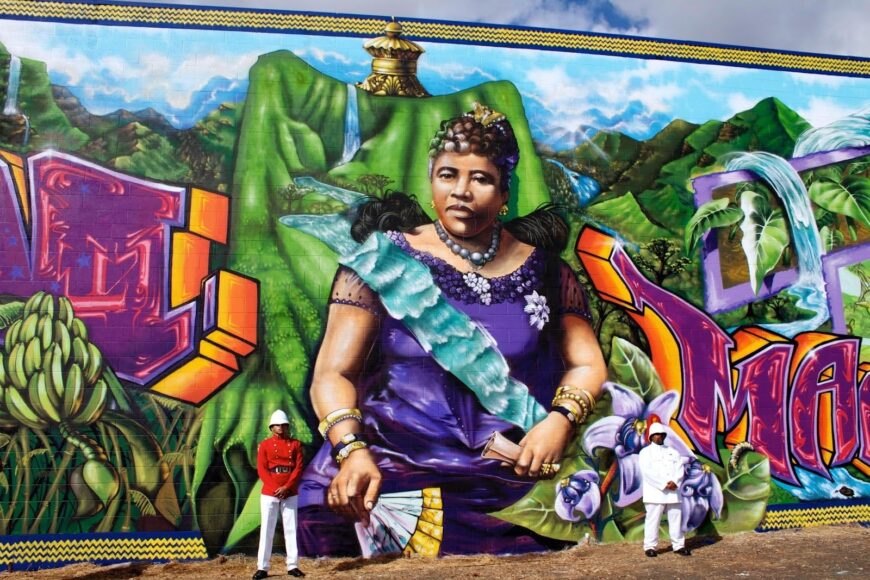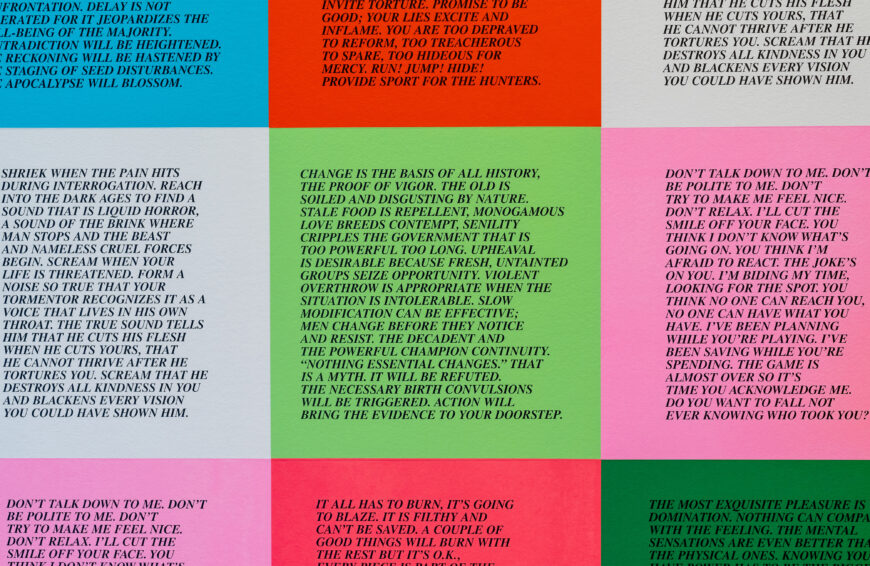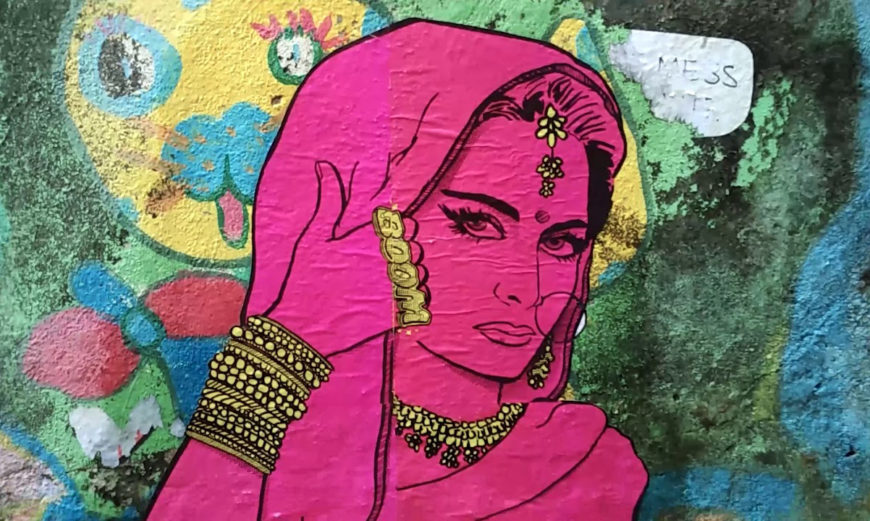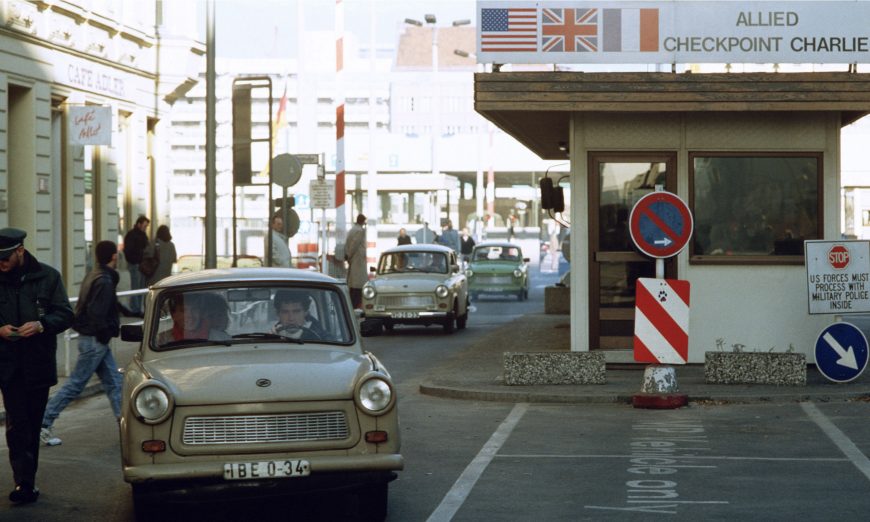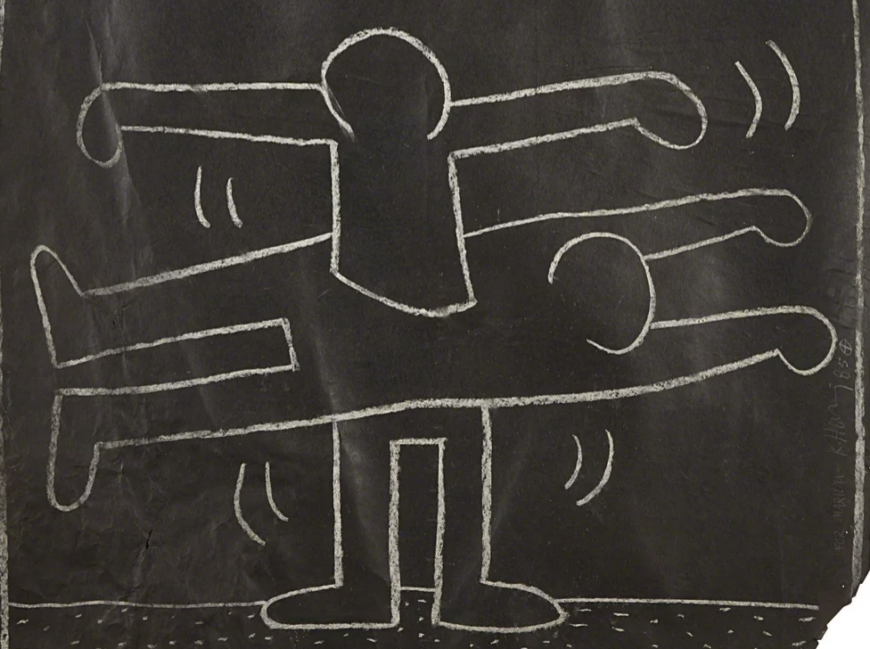
Estria Miyashiro, John “Prime” Hina, and others, Ola Ka Wai, Ola Ka Honua (As the Water Lives, the Earth Thrives), 2011, Honolulu (photo: Mārata Tamaira)
For Kānaka Maoli, as for other Native communities throughout the Pacific (and indeed the globe), the ability to self-represent through the contemporary arts has been a crucial means through which to revive and celebrate their histories and cultural traditions as well as assert grievances relating to the colonization of their homelands.
Murals in particular have functioned as a valuable mode of representation because they are squarely located in the visual panorama of everyday life, appearing on concrete motorway barriers and underpasses, construction fences, on the walls of industrial-commercial neighborhoods, schools, bus stops, and so forth. They function as sites for creative production that is at once affirming of Native Hawaiian sovereignty and resistant to ongoing colonialism, particularly as it relates to the relentless drive for development and the degradation of Hawai‘i’s precious natural resources, such as water. In “Missionary Graveyard,” Haunani-Kay Trask writes,
graveyard Hawai‘i Nei:
coffin buildings, concrete parking lots,
maggot freeways
smell of death
smeared across the land/killing in the heart. [1]
Trask’s poem is a keen lamentation for the loss of Hawaiian lands and waterways that have disappeared under tourism, overpopulation through the steady flow of transplants to Hawai‘i’s shores, and, most prominently, development. Of all the places in Hawai‘i that have perhaps been most discernibly affected by this “killing in the heart” is Honolulu. Encompassing the tourist centers of Waikīkī and Ala Moana, Honolulu is the proverbial “concrete jungle,” populated by towering high rises and permeated by roads that are perpetually congested with traffic.
Kokea Street in the Kalihi-Pālama district of Honolulu is a striking example of the city’s industrial-urban sprawl with its rows of warehouses, retail stores, and low-income, low-rise apartments. The only evidence of nature in this dry, asphalt-laden neighborhood are the trees that were planted in a vain effort to beautify the area, a narrow drainage canal of brown water, and a muddy bank that is littered with old tires, plastic bottles and bags, and other discarded trash. Presented with this scene of environmental degradation and industrial pollution, one would be forgiven for not knowing that the area at one time was populated by at least forty-five lo‘i (taro fields), all of them fed by the once-healthy and free-flowing Kapālama Stream. Kokea Street seems an unlikely place to find visionary artistic enterprise, yet just past a packed parking lot and a large expanse of cleared land marked for development, a wall of vibrant artistry looms into view.
Completed in 2011 and measuring two stories high and almost two hundred feet long, the graffiti writing mural Ola Ka Wai, Ola Ka Honua (As the Water Lives, the Earth Thrives) constitutes the third mural in the ten-mural Water Writes series. Organized under the auspices of the Estria Foundation, Water Writes is a community-building, social justice initiative that addresses, through the medium of public art—specifically graffiti-writing—environmental issues relating specifically to water sustainability in cities throughout the globe. [2] Ola Ka Wai, Ola Ka Honua was a collaborative effort that involved a multicultural cohort of twenty graffiti writers in total, including Kanaka Maoli artists Estria Miyashiro and John “Prime” Hina, who co-steered the project. [3] The mural took one month to complete and required 600 cans of spray paint and 30–40 gallons of house paint.
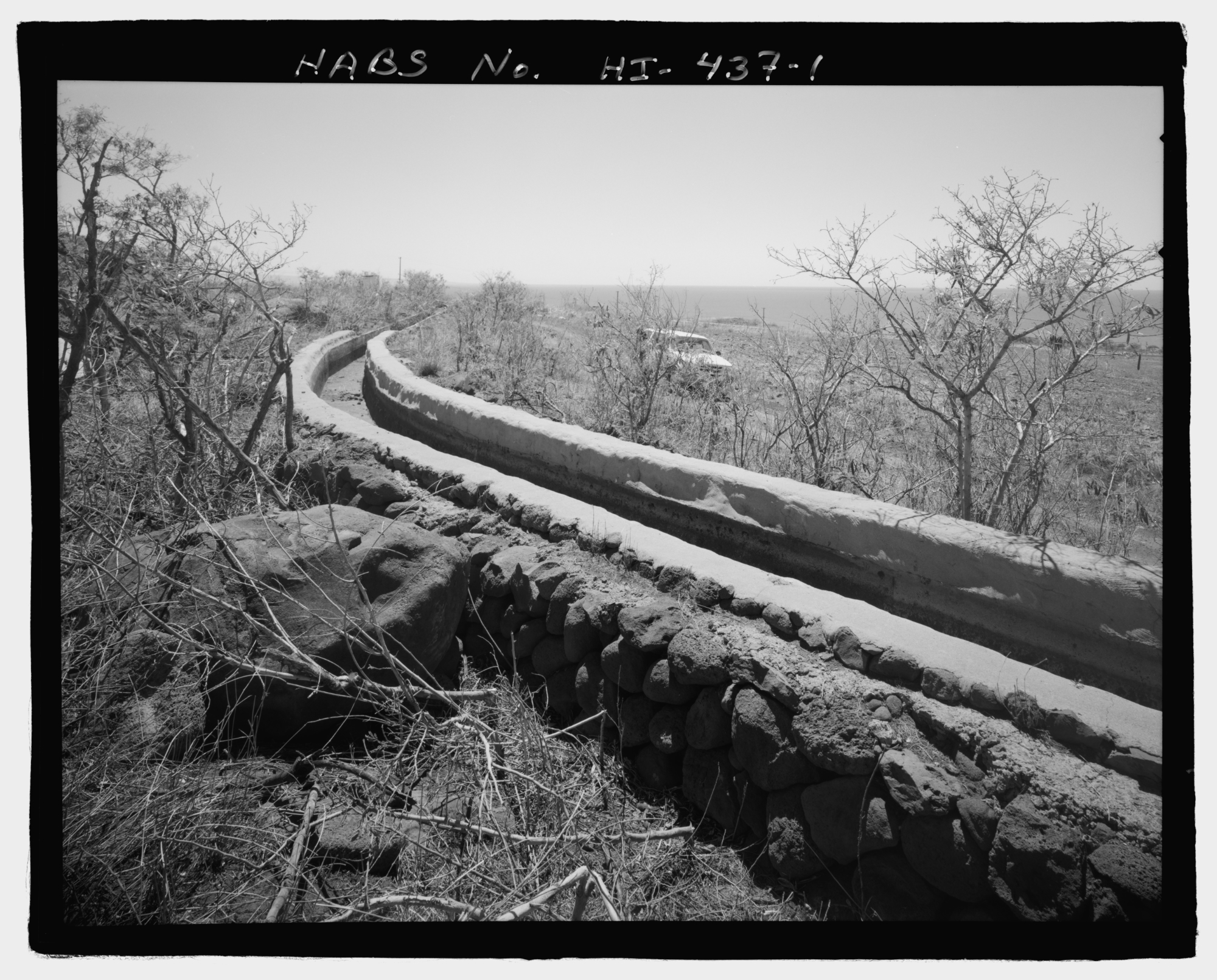
“Pioneer Mill Company, Upper Lahaina Pump Ditch & Makila Reservoir Ditch, Land of Launiupoko, Lahaina, Maui County,” c. 1933 (Library of Congress, Washington, D.C.)
Water under threat
In Hawai‘i, water has long been the subject of intense and ongoing debate. Beginning in the mid-19th century, streams and rivers across the Islands were diverted from their natural courses into ditch systems that carried water to initially feed the burgeoning sugar plantations of the 19th century and later to supply emerging suburban communities, businesses, and resorts.
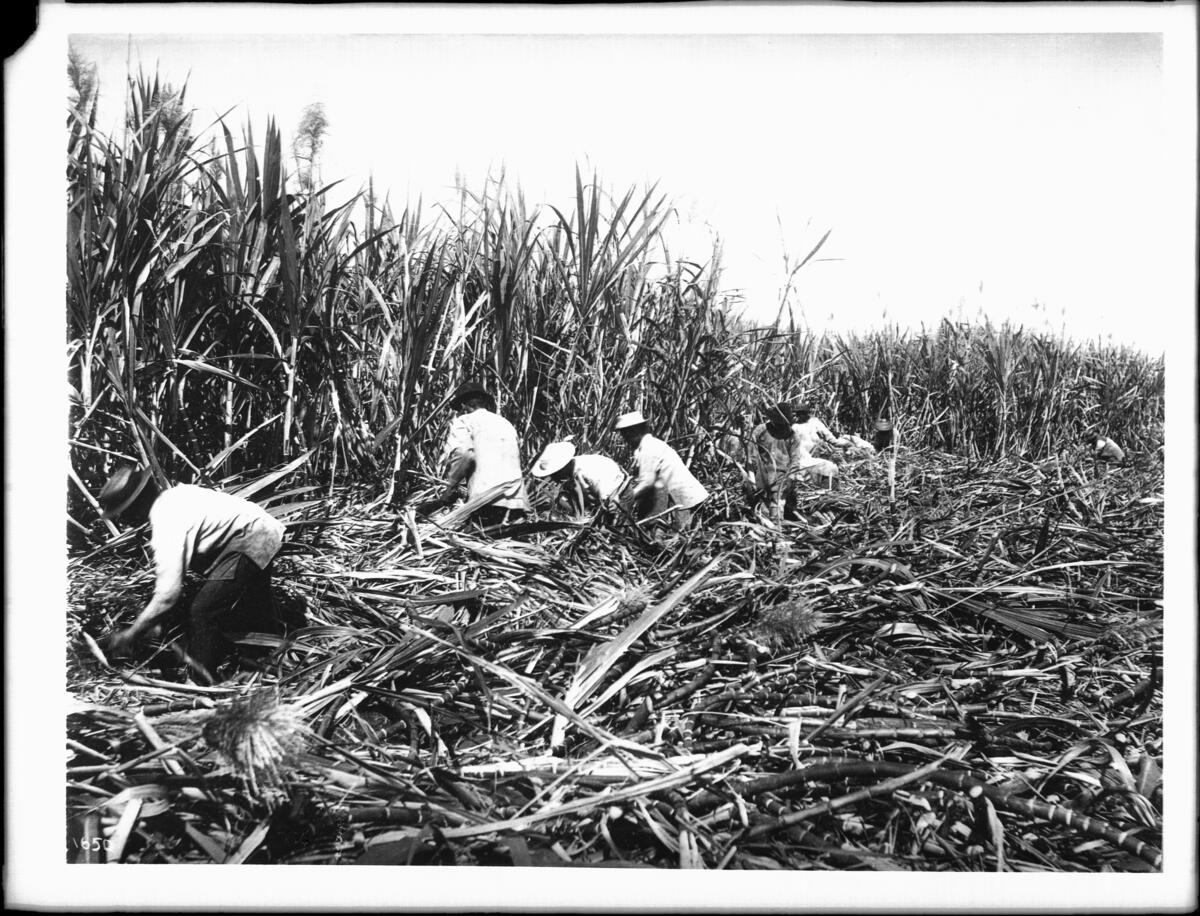
Workers cutting cane on a sugar plantation, Hawai’i, n.d. (California Historical Society Collection, University of Southern California Libraries, Los Angeles)
Today, despite its status as a public trust resource that is protectable under the Hawai‘i State Constitution and the state’s Water Code, water remains under threat. On the island of O‘ahu alone, the Waiahole Ditch system diverts up to 12.7 mgd (million gallons of water per day) to the drier leeward side to provide not only potable water for human consumption, but as well non-potable water for golf course irrigation, corporate agriculture, housing and resort development, and recreational landscaping. As Earthjustice attorney Kapua‘ala Sproat notes, “despite laws on the books, large companies—former plantations included—continue to . . . treat public water resources as their private property. Our management system has been reduced to might makes right.” [4] Ola Ka Wai, Ola Ka Honua presents an empowering vision of how things could be if the natural flow of the waters was restored and responsible Native-based stewardship of the ‘āina (land) was practiced across the Islands.
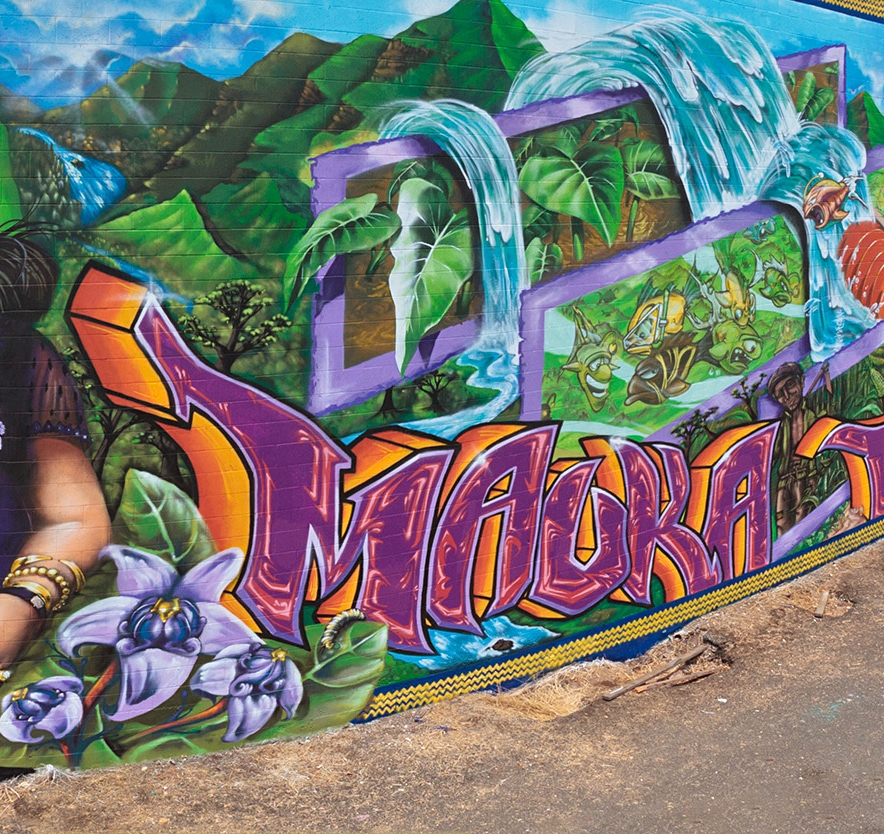
Ahupua‘a with three resource zones (detail), Estria Miyashiro, John “Prime” Hina, and others, Ola Ka Wai, Ola Ka Honua (As the Water Lives, the Earth Thrives), 2011, Honolulu (photo: Estria Foundation)
Flow mountain to sea
The brightly painted mural comprises three principal sections. On the right-hand side, the homeostatic system of a traditional ahupua‘a (land division stretching from the mountains to the ocean) is shown, each resource zone—kalo terrace, fishpond, and dryland agricultural field—being represented in discrete visual “stills” that are cleverly consolidated into the overall composition. The water from the mountains gushes through the different zones before emptying out into the ocean.
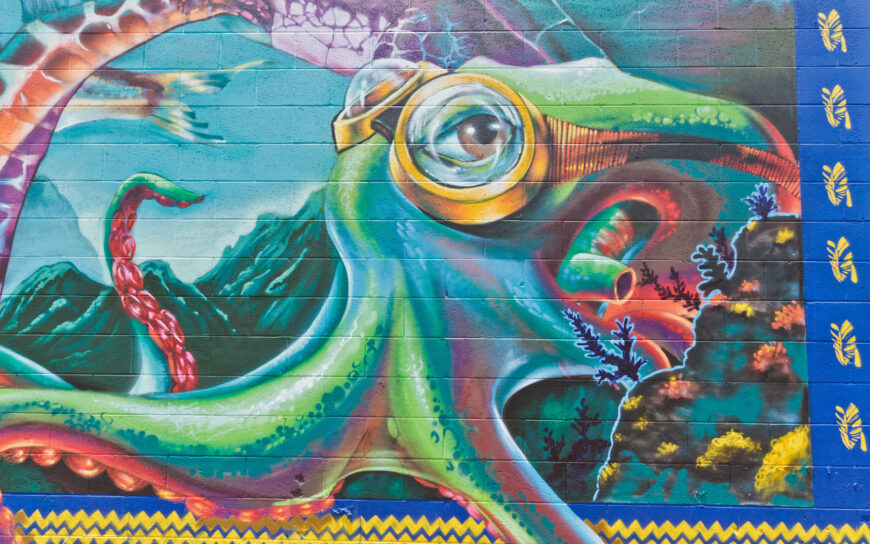
He‘e (octopus) (detail), Estria Miyashiro, John “Prime” Hina, and others, Ola Ka Wai, Ola Ka Honua (As the Water Lives, the Earth Thrives), 2011, Honolulu (photo: Estria Foundation)
Native marine fauna from the various aquatic habitats of stream, shoreline, and deep water are also depicted, such as o‘opu (gobie), oama (goatfish), he‘e (octopus), and honu (turtle).
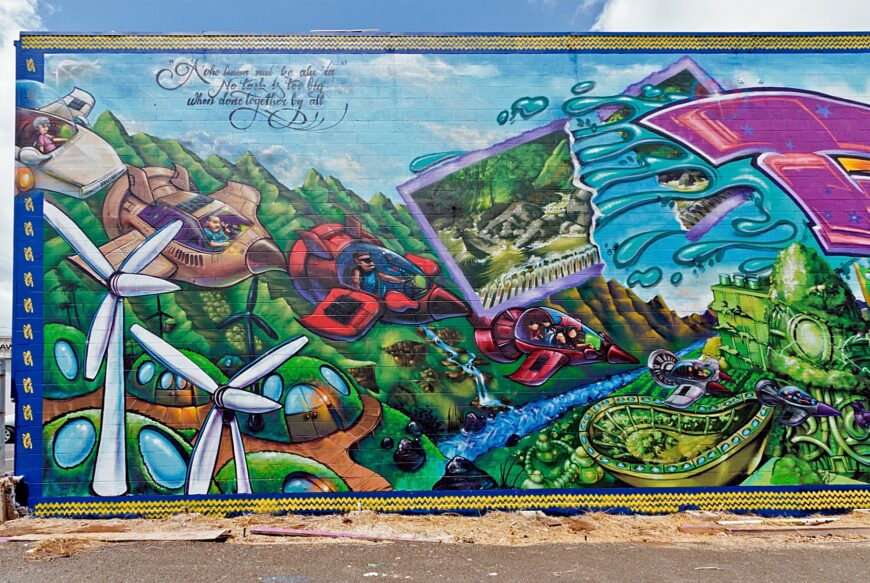
Ahupua‘a of the future (detail), Estria Miyashiro, John “Prime” Hina, and others, Ola Ka Wai, Ola Ka Honua (As the Water Lives, the Earth Thrives), 2011, Honolulu (photo: Estria Foundation)
This representation of past land and water stewardship is complemented on the left-hand side of the mural with images of what an ahupua‘a of the future might look like. A bird’s-eye view of a futuristic Honolulu reveals solar panel–roofed buildings, the walls of which are covered with living plants. Rather than dominate the skyline in a dreary hue of concrete grey, these verdant green mounds crouch unobtrusively on the landscape. The buildings share the space with present-day “green” technologies, such as wind and water turbines, and a catchment water system that feeds a communal garden. In a more whimsical imaging of the future, the artists also include anti-gravitational vehicles, which are operated by their human pilots.
Present-day realities are not precluded in this affirmative vision of environmentally balanced, self-sustainable living. Above the city-scape, ‘Īao Stream—one of four streams on Maui that have for over a century been diverted for commercial agricultural interests—is represented in the same kind of “still” used to frame the various ahupua‘a zones. Since 2003, Native Hawaiians have been engaged in a legal battle to have Nā Wai ‘Ehā (The Four Streams) of Maui, which includes ‘Īao Stream, restored and returned to the people. [5] In the visual representation of ‘Īao Stream, the grill through which the water is diverted is clearly apparent. However, what is equally unmistakable is the torrent of water that courses unimpeded through a giant tear in the image. The message is that these waters will not be held back, despite the political tactics of powerful corporate enterprises to control their flow. The words “Flow Mauka to Makai” (“Mountain to Sea”) that stream across the length of the mural function as a cohesive element that ties the entire composition together. Spoken out loud, the words are like a mantra willing the waters to once again flow unimpeded from the top of the mountains to the ocean. Hawaiian cultural values of cooperation and collective well-being are also invoked in the written ‘ōlelo no‘eau (Hawaiian proverbs) located on the left and right-hand side of the mural, respectively:
‘A‘ohe hana nui ke alu ‘ia
(No task is too big when done together by all)
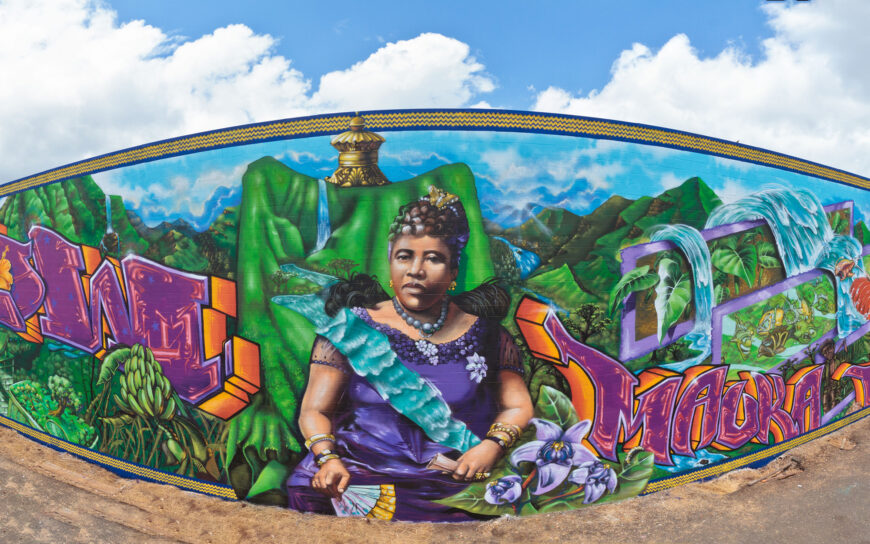
Queen Lili‘uokalani (detail), Estria Miyashiro, John “Prime” Hina, and others, Ola Ka Wai, Ola Ka Honua (As the Water Lives, the Earth Thrives), 2011, Honolulu (photo: Estria Foundation)
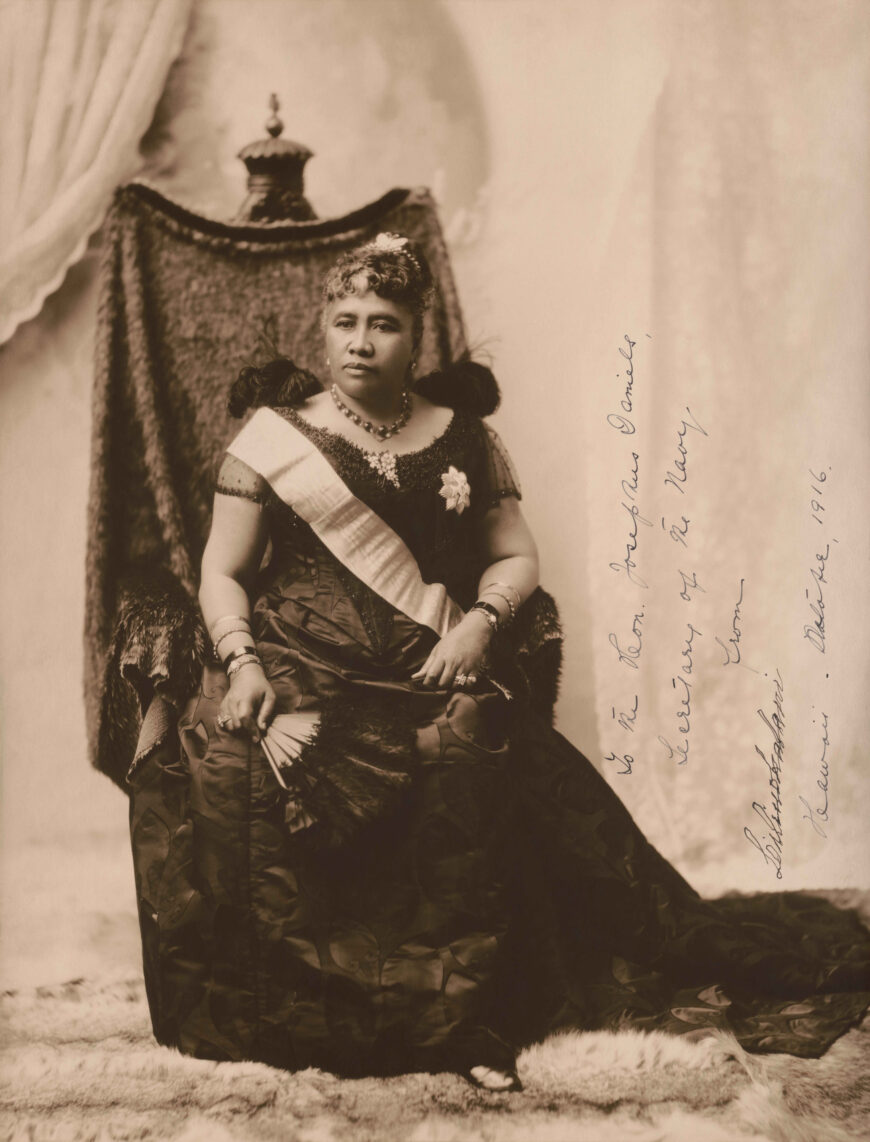
Queen Liliʻuokalani, the last sovereign of the Kamehameha dynasty that ruled the Hawaiian kingdom, c. 1891, gelatin silver print, 38 x 29 cm (Library of Congress, Washington, D.C.)
Unrelinquished Native sovereignty
Native sovereignty is a central theme in the mural and it is most conspicuously cited in the larger-than-life figure of Queen Lili‘uokalani, who is stationed at the center of the mural, between the past and the future. The image is based on a black-and-white photograph taken of the Queen at the beginning of her reign, which lasted from 1891–93. In the photograph, she is shown seated on her royal throne, over which is draped an ahu‘ula (feather cloak). In the mural, the cloak is artistically reconceptualized as a lush valley comprising Crown lands—lands that were confiscated during the 1893 overthrow of the Hawaiian monarchy—through which surges a rushing stream that cascades over the Queen’s right shoulder and across her heart to become her royal sash. Miyashiro notes that the orientation of the royal sash over the Queen’s heart was not only in keeping with the photographic source but also strategically positioned to indicate that “she’s still pouring her heart out to help us.” [6]
The deliberate inclusion of Queen Lili‘uokalani as the central figure in Ola Ka Wai, Ola Ka Honua may best be understood in the context of what anthropologist Sherry B. Ortner describes as a grammar of “summarizing symbols” or “objects of attention and cultural respect.” [7] In the case of the mural, the principal symbol of attention and cultural respect is the personage of the Hawaiian Kingdom’s last ruling monarch. Queen Lili‘uokalani’s image bears critical meaning for Kānaka Maoli who revere her as an icon of resistance and unrelinquished Native sovereignty. For instance, during sovereignty marches and protests her image is often used on flyers and posters along with her famous motto ‘onipa‘a, a Hawaiian term meaning steadfast, firm, and resolute and which was used by Queen Lili‘uokalani to fortify her people when the Hawaiian Kingdom was forcibly and illegally overthrown. For Hina and Miyashiro, the emphasis on the Queen is reflective of their own political conviction that the Hawaiian Kingdom was never terminated and remains in existence to the current day. From Miyashiro’s perspective, the image of Lili‘uokalani “reaffirms for people that are looking at it: I am Hawaiian and we are a Kingdom.” [8]
Thus, the Queen’s image functions as a contemporary rallying point for the affirmation of sovereign Hawaiian identity, a symbolic counterpart to the more concrete claims that are being made by Kānaka Maoli in the areas of law and politics.
As a symbolic display of Native sovereignty the mural was further enhanced at the unveiling—which took place 7 July 2011 and included a blessing, hula performance, and an appearance by singer-songwriter Palani Vaughan—by the presence of the Hawaiian Royal Guard, who were stationed in front of the Queen’s image for the entire event, despite the intense summertime heat. For Miyashiro, it was a lesson in how seriously Kānaka Maoli viewed the mural and how the Queen continues to resonate as a symbol of Native pride and identity.
The unveiling of the mural not only revealed the strong feelings of fidelity Kānaka Maoli continue to have for their sovereign, but it also exposed a resolute resistance to U.S. colonialism. In a show of Indigenous national pride, Palani Vaughan performed the Hawaiian patriotic song “Kaulana Nā Pua” (“Famous Are the Flowers”). Written in 1895 by Ellen Kekoaohiwaikalani Wright Prendergast—a good friend of Queen Lili‘uokalani—in opposition to the illegal annexation of the Islands to the United States, the song was a statement of rebellion that pledged loyalty to the Queen and denounced the schemes of the haole (white) annexationists. [9]
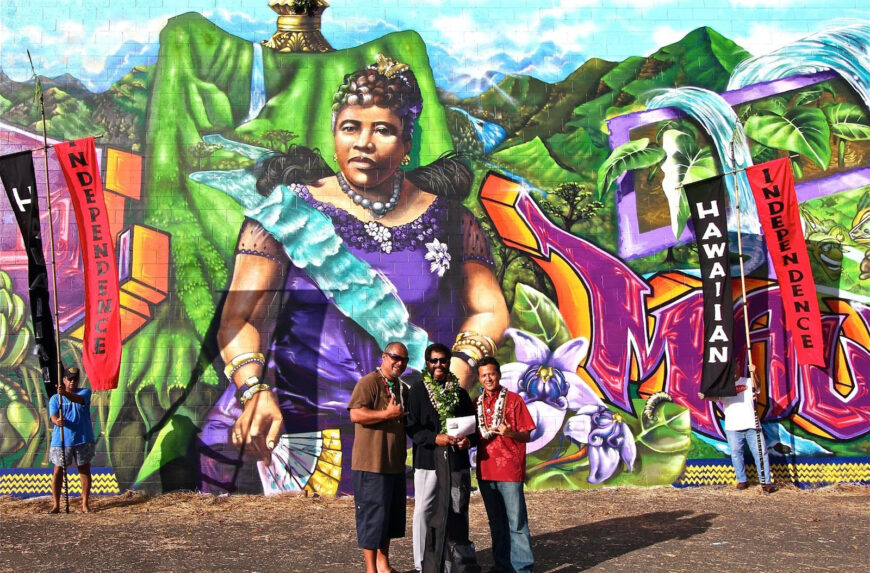
John “Prime” Hina (left), Palani Vaughan (center), and Estria Miyashiro (right) stand in front of Ola Ka Wai, Ola Ka Honua during the mural’s unveiling ceremony, 2011 (photo: Paula Ota)
In one particular photograph, Hina, Miyashiro, and Vaughan are shown standing in front of the Queen’s image during the unveiling celebrations. Flanking the trio are two standard bearers holding flag banners that read, “Hawaiian Independence.” The photograph illustrates in a profound way the intersection between Native art and politics in Hawaiʻi.
A call to collective engagement
Ola Ka Wai, Ola Ka Honua serves as a testament to the strategic use of art by Kanaka Maoli practitioners in their bid not only to uplift their own people with visual affirmations of Native sovereignty but to also hail non-Kanaka Maoli living in the Islands as part of a broader call to collective responsibility and action. As Miyashiro states:
When we paint outdoors, hundreds of thousands of people see it in a week. Millions of people see it in a year. You know, academics talk about taking the art—and not just visual art, but dance and performance, and what have you—taking all of those art forms out of the institutions and going into the community where the people are. [10]
Indeed, in its inclusive call to collective engagement, Ola Ka Wai, Ola Ka Honua may succeed where political rallies and other high-profile sovereignty initiatives have been unsuccessful. It opens space for the viewing public to be transformed in profound and, one might hope, lasting ways—conscientized as Paulo Freire would say, raised to new levels of awareness. This is not just the case at the collective level, but as well the personal. Prime and Estria both describe the mural as a landmark moment in their lives because it helped them realize the significance of what they were doing, not just as individual artists but also as artists who are part of a collective effort to assert Hawaiian sovereignty through art: “This is our journey as artists, as people [who are] upholding the culture. And it’s a heavy burden. Not really burden. It’s a heavy honor.” [11]


